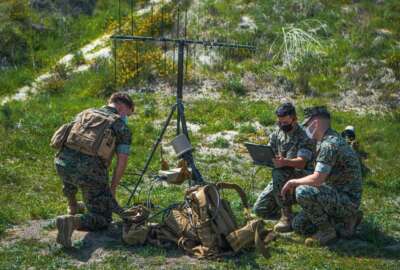How would a new $6.5B advanced research projects agency for NIH work?
The Biden administration has proposed a $6.5 billion advanced research projects agency as part of the National Institutes of Health.
Best listening experience is on Chrome, Firefox or Safari. Subscribe to Federal Drive’s daily audio interviews on Apple Podcasts or PodcastOne.
Given what’s happened over the last year and a half, you’d think the Department of Health and Human Services would have something which the departments of Defense and Energy, as well as the intelligence community have — namely, an advanced research projects agency. Now the Biden administration has proposed just that: a $6.5 billion ARPA Health as part of the National Institutes of Health. With how an ARPA Health might work, Federal Drive with Tom Temin spoke with NIH Director Dr. Francis Collins, starting with the question, isn’t the NIH itself a sort of ARPA already?
Interview transcript:
Dr. Francis Collins: Well, I appreciate you’re phrasing it that way. Because I do think of NIH as being bold and having done amazing things to advance the cause of medical research over many decades. But what ARPA-H would provide us would be with a new division that had some new authorities that allowed us in special circumstances to be able to move even more quickly and to take more risks the way that DARPA has done for defense over the course of decades, and has had some pretty good successes, like the internet and GPS and self driving cars and things like that. There are instances where biomedical research has opportunities like that. And our ability to go after them is somewhat impaired by the way in which we traditionally have been doing research, which has been incredibly successful, but maybe doesn’t work for everything.
Tom Temin: Because there have been some recent instances of this type of crash research, if you will, probably not the best word for it. But, whatever happened to the KidneyX project, for example? That seemed really promising and kind of a rapid way of getting around a problem that had been unsolved for decades.
Dr. Francis Collins: Well, yeah, there have been instances, and I guess, since I’ve been at NIH for 28 years, I’ve been part of some of them, beginning with the Human Genome Project, which was very much a radical departure from the usual way that biomedical research was conducted. Usually, an investigator would have a good idea, they would send us a grant, we would go through a rigorous peer review, that was followed up by a second level of review about program priorities. And if all went well, and that grant landed in the top 20%, and then it would get funded. But that was about a year later. It would not be possible with that mechanism, though, to pull together a big team and do something like the Human Genome Project. Who would apply for that? So that requires a different kind of thought process, a different kind of mechanism. The genome project was very successful, and 13 years, there are things now that we would like to do even faster than that, and we don’t quite have a straightforward way to support them. You know, Tom, I’ll go to what’s happened in the last year and a half with COVID-19, we NIH sort of put in the position of needing to bring all of the most vigorous, rigorous science to bear on this worst pandemic in 103 years, and we did stuff as a result of that need, that we’ve never done before, leading to vaccines being approved in 11 months, leading to more than 20 therapeutic agents run through rigorous trials, leading to diagnostic tests, many different technologies that otherwise would not have made it out into the clinic. I learned from that, that there are ways to do things more rapidly in the presence of a real pressing need. But we had to kind of make it up as we went along. Wouldn’t it be better to have a framework for those kinds of things? And not just for a pandemic, but for the next breakthrough in cancer, or Alzheimer’s, or diabetes, or a rare disease, everything from molecular problems to societal problems, there are projects like that, that right now are hard to do. So why don’t we make it easier? That’s what ARPA-H aims to do.
Tom Temin: And when you mentioned new authorities, for example, could that extend to say, going to clinical trials of experimental types of drugs where now sometimes that’s the stage at which things get hung up for years?
Dr. Francis Collins: Well, there is this traditional phrase called the Valley of Death, which is actually a pretty accurate description of what happens to a lot of promising clinical advances, where you get to a certain point where you could see the potential, but it’s not something that commercial sector is ready to invest in, it’s too high-risk or the market is too small. And so it just goes into the Valley of Death and dies. And people therefore are not benefited by it. If we had an entity, and ARPA-H could be a really good one, to pick up those that seem most promising and be willing to fail. Because that’s necessary. If you’re going to get work done, you’re going to have to accept the fact that isn’t always going to work. And then make that investment, bring it along with clinical trials to the point where it has been de-risked. And then if a commercial entity says, “Okay, I’m ready now.” Fine, hand it over. We never want to do anything at NIH that’s basically taking over space that the private sector wants to use, but we sometimes need to help get things into their space so they can license them and run away with them and make the things happen that the public needs.
Tom Temin: But how would it interact, say with the FDA space?
Dr. Francis Collins: Well, we will need to have close collaboration between ARPA-H as it’s currently proposed, and the FDA. And we already know how to do that. My gosh, this year, and even before this, interactions between NIH and FDA to be sure there are no surprises, have been critical. I probably speak to Janet Woodcock, the acting FDA commissioner, several times a week, and certainly with the vaccine efforts, interacting with her staff, especially Peter Marks has become a very important part of our business. Not that we try to influence their decisions, that would not be a good thing, but that we don’t surprise each other with what’s coming. And if you’re going to run, for instance, a risky clinical trial, before you start it, you probably want to run the design past the FDA. And so you can find out that if the trial actually works, FDA is going to say, “Okay, bingo, you got it,” as opposed to, “Well, you didn’t design your trial right, you better start over,” and then everybody loses.
Tom Temin: And getting back to the $6.5 billion proposal, I guess, for 2022 that is in the budget for NIH, how does that break down in terms of people and money for actual grants that would go out?
Dr. Francis Collins: So it’s pretty bold, this six and a half billion dollars from a standing start. And that would be what ARPA-H would need to do. We can’t even begin to stand this up until the budget’s actually approved. And, Tom, you know that budgets for the federal government often don’t happen to emerge on October 1, even though they’re supposed to…
Tom Temin: We can hope.
Dr. Francis Collins: …So probably, we might then see something happen by December. Fortunately, the president’s budget proposed, and the Congress seems to agree with this, that that money doesn’t all have to be spent that first year, that this could be stretched out over three years. What would we need to do? First of all, we need to hire a director who has the right characteristics to lead this effort. I’m thinking of somebody who has private sector experience, who’s an entrepreneur, who has vision, who is bold, who’s a really good communicator of that vision, who can then go out and recruit these program managers, maybe as many as 50 or 100 over the first year, who are really going to be the ones who figure out what is an appropriate ARPA-H project? How do we design it? How do I pitch that to the director? If he approves it, how do we get it started? How does it have milestones so that you know if it’s succeeding or failing? All of those things are going to need to get going like on day one. So given all of that, by the end of fiscal year ’22, I would expect we would have 50 or 60 projects going, but probably not a lot of results. Those results hopefully would come a year or two after that as the project really ramps up, scales up, staffs up, and gets a lot of things done. But this is not the traditional grant mechanism where somebody sends in an application. The program managers figure out what they think the opportunities are. And they can go out and recruit partners, including small businesses who might never consider sending a grant NIH, but who might be just the right partner to get something to happen.
Tom Temin: Because we’ve had language over the years, there have been moonshots and so forth where people expect, well, we just throw enough money at it. There was a cancer moonshot. And I don’t know whatever happened to that. I think it may be plunged back to the ocean or something. But these would be more focused than that?
Dr. Francis Collins: No no no, I will resist that description. We are pushing that pretty hard, but not in the same way as ARPA-H might now be able to do and contributing to that.
Tom Temin: And do you have any sense of the areas, and not the signal where you’ll spend money, but areas that are ripe for an ARPA Type H? I think Alzheimer’s comes up a lot in these conversations. Anything else?
Dr. Francis Collins: Certainly the president in his vision about this is thinking particularly about cancer, given the tragic death of his son to a brain tumor. But it’s also clear that this is intended not to have a menu of specific diseases which will get a certain number of projects, this is going to be dependent on scientific opportunity. I’ll be amazed, with the budget that’s being proposed which will support hundreds of projects, if there won’t be quite a few on cancer, and quite a few on Alzheimer’s and diabetes. But there will be some on diseases that are quite rare, where there happens to be a particularly golden opportunity to push things forward and move across that Valley of Death. I think there will be a lot of technology development efforts. I’ll give you an example that I’m fond of, hypertension. Here’s a condition that’s incredibly common in our society, and also a cause of health disparities. We know we don’t manage hypertension very well. People who have that show up in the office of a physician now and then, there’s white coats all around, the blood pressure measurements are of questionable validity. Medicines get given. Maybe they’re taken, maybe they aren’t. We don’t really manage this the way we ought to for a chronic disease that’s a major cause of heart attacks and strokes. If we really had reliable ambulatory 24/7 measures of blood pressure, it would totally transform the way in which we diagnose and treat this condition. And there’s no reason with the way technology is now advancing that we can’t get those kinds of wearable sensors optimized. There are some options out there, but they’re not quite there yet. I think this is a place where ARPA-H could basically serve as kind of a venture capital organization and say, “We’ve got money. If you’ve got a great idea about how to do this, come forward, we’ll offer you a lot of advice, business, technology, engineering, supply chain, manufacturing all that, and see what you got. And if it looks really good, we’ll help you scale it up, we’ll help it get into the market.” And in the course of a couple of years, we might actually have a really good outcome, which otherwise may take a lot longer. That’s just an example.
Tom Temin: And the final question with respect to the NIH institutes as they are now, there could be a little bit of internal jealousy there if the great stuff is going to ARPA Health. And what about our institute which specializes in infectious diseases, cancer, blood, heart, you name it? So there’s a little turf issue here.
Dr. Francis Collins: Well that’s one reason why ARPA-H really should be located at NIH, and not off in some other part of the government where I think that kind of unfriendly competitiveness might happen. So, basically though, I think the institutes are pretty excited about this. It extends their reach. All of those institute directors have projects they would like to see happen within their portfolio, but they don’t really have the mechanism to do so. And so they think of ARPA-H, not as detracting from their capabilities, but augmenting it, and they’ve already come forward, many of them with great ideas about projects that ARPA-H could undertake. And I think they will be cheering for this. They want to be sure, and I get this, that this is not something where the budget for ARPA-H is taken out of their budget, and this needs to be an addition, not a substitution. And the Congress totally gets that. And when you saw what the House Labor, Health and Human Services appropriators did, they both recommended support for ARPA-H but also recommended an unusually large increase for the rest of NIH making it clear that both are valuable and they shouldn’t be seen as competitive.
Jared Serbu: Dr. Francis Collins is director of the National Institutes of Health.
Copyright © 2025 Federal News Network. All rights reserved. This website is not intended for users located within the European Economic Area.
Tom Temin is host of the Federal Drive and has been providing insight on federal technology and management issues for more than 30 years.
Follow @tteminWFED






